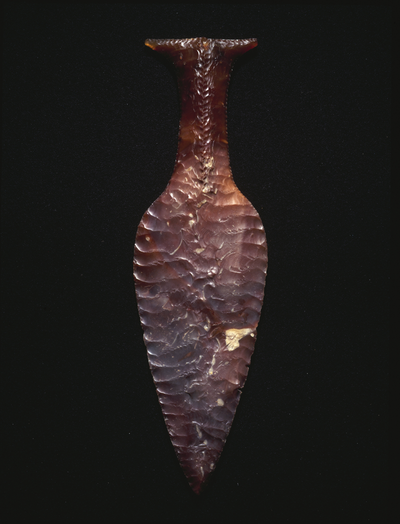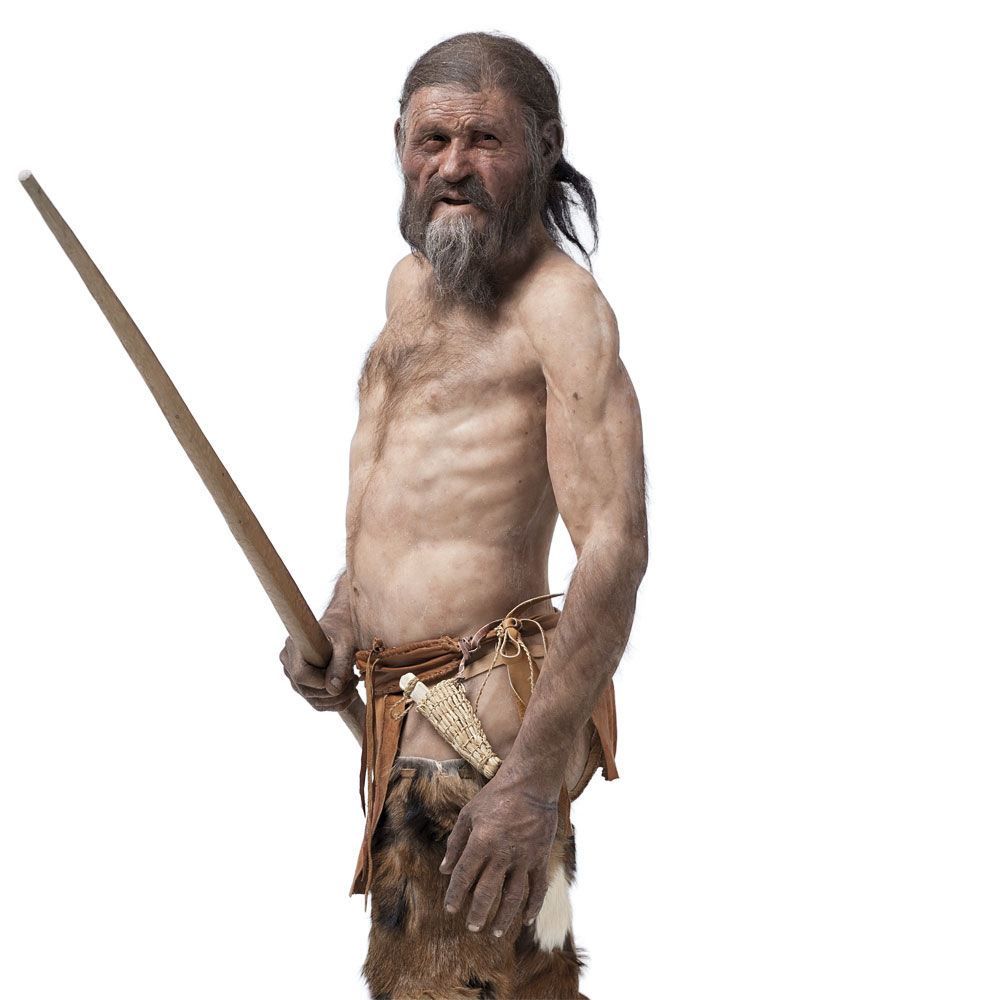
Weapons of the Toralai
by Cab DavidsonMany paleolithic weapons and tools are made from stone. Flint is preferred for arrowheads, spear heads and blades, whereas axes are ground from a range of stones that must be hard enough to take an edge. Stone weapons are relatively robust, (blunt after 10 rounds of combat, -1 to hit and damage per 10 rounds use) but each can only be reworked to gain a new sharp edge a number of times.
Higher status axes and occasionally daggers are occasionally made from copper, often with only a small amount of the worked metal to tip otherwise wooden weapons. While copper does blunt rapidly in such use (-1 to hit and damage per 5 rounds use) it can be resharpened far faster than a stone tool.
Bows are made with the best wood available for the job, and the Neathar understand the need to combine the properties of harder and softer layers of wood from a tree to obtain good results. May prefer yew heartwood in the construction of bows, and arrow shafts fashioned in ash, viburnum and and dogwood are known. Shafts are typically fletched with swan or goose feathers.
Other weapons are fashioned from stone, antler, bone, wood and horn, and specific tribes have specialities with different weapon types.
Axes
Stone and copper axes are used by .
Copper is a rare and valuable commodity and its ownership denotes status. However, such weapons are not merely ceremonial, they are used in combat and as daily tools if available. Such axes can be used in melee, inflicting 1d6 damage, but with such a small amount of copper weighting the axe head they cannot be balanced as throwing weapons.

Replica of an upper paleolithic copper axe, source: Wikipedia
Stone axes can be balanced for throwing, and while usually of lower status are practical both as tools and weapons.
Axes are usually bound with pitch or wood tar (distilled most often from birch wood) and leather strips, and are among the most commonly owned weapons and tools as used by paleolithic Neathar.
Daggers
Copper daggers are exceptionally high status items, usually only found in possession of great chieftains or kings. Stone daggers of exceptional quality are also highly prized but very practical weapons more often used by the paleolithic Nethar, and may be fashioned with a stone handle or even a stone tang.

Hindsgavl dagger, source: National Museum of Denmark
There are exeptional examples of daggers being made from clear rock crystal, dark obsidian, and other exotic materials. Such daggers are often worn very visibly as prestige status symbols, but rarely used.
Spear
For all Neathar, the spear is a primary weapon of war and of the hunt. Heads are rapidly fashioned in stone, with shafts being made from ash or hazel being most common. Spearheads are often complex and made for specific purposes, barbed spears being common in hunting and fishing, and heavier heads being used for war. Lighter spears, the equivalent of javelins, are often used with a spear thrower - a short, grooved stick that effectively lengthens the throwers arm, providing greater range and punch to the weapon. Many Neathar warriors are skilled in the use of the spear thrower, and guard this knowledge from outsiders.

Spear thrower in use. Source: Wikipedia
Maces and Clubs
Both stone and wooden bludgeoning weapons are employed by the Toralai. Clubs are perhaps the most primitive of all known weapons, and the Toralai make fire hardened wooden clubs, often protected and further hardened with birch tar. These are not viewed as high status weapons, but fulfil the role of hammer, prybar and weapon according to need. A hardened stick for weighing things down, breaking things open or knocking something into the ground is always of worth.
By extension maces, constructed by adding either a stone head or flakes of flint to the end, are also popular. Mace heads are rarely well crafted, being viewed by the Toralai as functional rather than decorative. Maces, being blunt weapons, are more robust than bladed stone weapons, but do still break. On a natural attack roll of 1 a stone mace head will crack, and require replacing with another stone. This can be done by any character with appropriate materials (twine or leather straps, a stone to work the new head in and some tar). While other more advanced Neathar tribes can craft fer more elaborate mace heads, this is seen as a waste by the Toralai, but they can use such maces crafted by other tribes with no penalty.

Otzi the iceman. Source: Tyrol Museum of Archaeology
Bows
Many paleolithic Neathar tribes are surprisingly adept bowyers. While the full power of later warbows is beyond them, the bows they construct are around the size of longbows but equivalent in range and use to shortbows. These bows are used to hunt and in war, and are accompanied by a expertly fletched arrows with tanged arrowheads crafted in flint or bone. These arrowheads are effective against animals and unarmoured opponents, but do suffer a -2 to hit when targetting a foe wearing metal armour. Many tribes of Neathar are skilled bow hunters, and have developed a range of general skills that boost their chances of taking prey with a bow. While barbed arrowheads are used in hunting, narrower, needle-sharp arrows are favoured in war.

Arrowheads. Source: Paleolithic Man "The Old Stone Age" 250,000 BCE to 10,000 BCE Early Homo Sapien Life
Boomerang
Thrown boomerangs are effective for hunting small game, and are highly esteemed by the by many tribes who view them both as practical weapons and as objects of status. They are sometimes highly decorated, being convenient items to carry and to work with with over a longer period in moments of free time. They are most often made from bone, and the highest status boomerangs are carved from tusks or bones, and they are usually highly polished as a matter of pride.

Mammoth Ivory Boomerang. Source: The Non Australian Boomerang
Slings
While the the paleolithic Neathar are familiar with and indeed use slings, these weapons being easy to make and to use, they rarely work sling bullets to accurate form and thus slings are normally used only as part of the hunt, to herd prey into the ambush of awaiting bow and spearmen. However, at a push they are also useful as weapons, but paleolithic neathar slignmen suffer a -2 to hit when using the unworked stones more often used to drive prey.
Blowgun, hunting
In common with most other primitive civilisations, the Toralai have developed the capacity to hunt small game with blowguns. The hunting blowguns they use are long, 5' or longer, and are used with darts fashioned from fire hardened wood and rabbit fur flights/wads. The work involved in making such darts is much less than for making an arrow, as a consequence blowgun darts are preferred for hunting smaller game.
Nets
The Toralai are adept at making and using nets to catch fish, and frequently use weighted nets to take fish in rivers and lakes. While not primarily used as a weapon, it is not unknown for a cunning Toralai warrior or hunter to use a net to entangle a potential foe. Weighted nets are rarely bigger than 10' across.
Bolas

Paleolithic bolas stone. Source: Wikipedia
Some paleolithic Neathar have become adept at catching prey by delaying them with bolas to allow spearmen to close and make a kill. This is especially popular among tribes who utilise mounts to chase down prey, maximising the value of a limited number of tamed beasts by using them to slow prey rather than make kills. Bolas are typically fashioned from plant cordage and stones carved to be spherical, and are as effective when constructed by paleolithic Neathar as by any other culture.